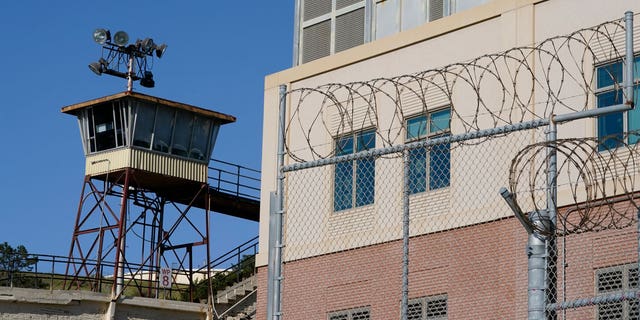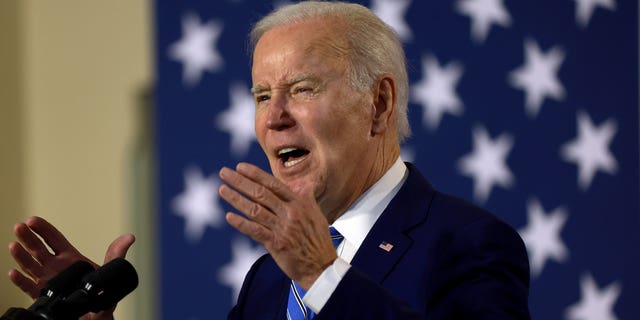New prison data blows up narrative that low-level drug offenders are filling up US prisons: experts
Newly revealed state inmate population statistics contradict the popular argument from criminal justice reform advocates that prisons are largely filled with nonviolent drug offenders, some experts said.
Data from the Bureau of Justice Statistics (BJS) show only 12.6% of state prisoners are behind bars for drug-related crimes and only 3.2% are locked up on possession charges – while five times as many people are in state prisons for violent crimes rather than drug charges.
“If you listen to people on the left, you’d think that everyone who has a joint in their pocket is getting sent to prison for 20 years, which just is not the case,” Zack Smith, a legal fellow in the Heritage Foundation’s Meese Center for Legal and Judicial Studies, told Fox News Digital.
Prominent Democrats and some Republicans across the country have pushed to decriminalize drugs by arguing, in part, that harsh drug laws have led to a prison-population boom.
DEMOCRATS CHAMPION ‘EQUITY’ BUT SHRUG AS RADICAL CRIMINAL JUSTICE REFORMS HIT MINORITIES THE HARDEST
In a 2019 tweet, Democrat Rep. Alexandria Ocasio-Cortez suggested on Twitter that the “reality” of the U.S. prison system is “nonviolent” people “stopped w/ a dime bag.”
President Joe Biden has issued thousands of pardons for marijuana crimes while insisting that “no one should be in a federal prison solely due to the possession of marijuana; no one should be in a local jail or state prison for that reason, either.”
Massachusetts Sen. Elizabeth Warren, a Democrat, said in 2018 that “more people [are] locked up for low-level offenses on marijuana than for all violent crimes in this country.”
Smith and Keith Humphreys, an American psychologist and Esther Ting Memorial professor at Stanford University, told Fox News Digital that those positions simply aren’t backed up by the data.
“It’s been a longtime talking point, particularly around cannabis legalization, to say our prisons are full of pot smokers and nonviolent drug offenders,” Humphreys told Fox News Digital. “It’s just something that has never been true, certainly for cannabis. You can get a night in a jail still for cannabis but going to prison is pretty much impossible anymore, not that it ever was possible.”
Humphreys said that even at the height of the crack cocaine explosion in the 1980s, only about one in five state prisoners were incarcerated for a drug charge of some form.
BIDEN DOJ ‘PUBLIC SAFETY’ PUSH SHELLS OUT $57M FOR ‘RACIAL EQUITY,’ CRIMINAL ‘JUSTICE SYSTEM REFORMS’

Humphreys explained that “violent crime is driving” prison populations in the United States as evidenced by the data showing 62.4% of state prisoners are serving sentences for violent crimes. The other 40% includes people who previously committed violent crimes or who pleaded down from a violent offense to a lesser offense, he said.
Smith agreed, saying people with simple possession charges – especially first-time offenders – “probably pled down” to those charges from a more serious charge.
“For instance, a lot of times if someone is potentially facing possession with intent to distribute charges, which carry much higher penalties … the prosecutor might plead down to simple possession charges in that case,” Smith said. “So, most of the time, I would suspect that’s what’s going on.”
Smith also echoed the conclusion that prison populations are driven by violent crime and not “low-level drug offenders” not just in recent years but historically.
“Between 1960 and 1990, the rate of violent crime in the United States surged by over 35%,” Smith told Fox News Digital. “It’s the biggest increase in our country’s history, and so it’s that increase in violent crime that was the increase in incarceration and the increasing of incarceration rates. It’s not minor drug offenses or really drug offenses, period.”
Smith said there were 43 million drug arrests in the United States between 1980 and 2012, which “sounds like a lot” until you consider that there were 445 million total arrests during that same time frame, which he said shows that “drug arrests accounted for less than 10% of all arrests over that roughly 32-year period” and runs contrary to the reform narrative.
TUCKER CARLSON: NORMAL PEOPLE DON’T WANT CRIMINAL JUSTICE REFORM, THEY WANT CRIMINAL JUSTICE ENFORCEMENT

“Even if you go all the way back to 1997, the heart of the tough-on-crime era, if you will, only 1% of all prisoners were in prison for a first- or second-time nonviolent drug offense, and only 4% of state prisoners in 1997 were considered to be drug kingpins,” said Smith, who is authoring an upcoming book titled “Rogue Prosecutors” about the progressive prosecutors across the country implementing what they call criminal justice reform.
Liberal mega-donor George Soros, who has spent billions pushing for criminal justice reform and backing the progressive prosecutors that Smith’s book discusses, has often advocated for an end to “mass incarceration” through his Open Society Foundations, which contends that “minor crimes” have “filled U.S. jails and prisons to overflowing.”
Fox News Digital reached out to Open Society Foundations for comment on the latest BJS statistics – a spokesperson for the group responded only with a disparaging comment about Fox News.
Humphreys also took issue with the argument from many activists who claim that violence is driven by the fact that drugs are illegal and violent crime would go down if drugs were legalized.
“The problem with that reasoning is that the No. 1 drug involved in violence in the United States by a big margin is alcohol, which is, of course, legal,” Humphreys said. “So, it doesn’t follow at all – from this data – that this just proves their point all along. No, it doesn’t really.”
Hannah E. Meyers, a fellow and director of policing and public safety at the Manhattan Institute, responded to the latest BJS statistics by pointing out the connection between drugs and violence that is often ignored by the political left.
“Those who decry how the U.S. justice system treats drug offenders also ignore the disturbingly tight relationship between drug offending and other, often violent, offending,” Meyers told Fox News Digital. “An earlier BJS survey found that 22.4% of drug offenders in state prison were violent recidivists and 26.4% had three to five prior sentences. Over 13% of sentenced drug offenders had six to 10 prior sentences.”
WE CAN FIX BAD BAIL REFORM BY PUTTING PUBLIC SAFETY FIRST

Meyers also pointed to a BJS survey that found that 38.4% of state drug possession offenders were rearrested within a year of release; by year 5, that percentage grew to a 73% rearrest rate.
Of all state drug offenders, 28% of those released in 2012 were rearrested for a violent offense within five years; released drug offenders were more likely to be arrested again within five years for a violent offense than were those released for homicide or rape.
“Therefore, the new BJS data only adds to a longstanding picture: it is not possible to simply separate out offenders held in for drug possession – or even for all drug crime – and safely reduce the U.S. prison population by showing them lenience,” Meyers said. “Not only do they make up a small and diminishing proportion of a concurrently shrinking number of total state inmates, drug offending and violent offending are deeply interwoven among the prison population.”
Proponents of the idea that inmates with drug convictions are filling up prisons often point to the fact that 46.7% of prisoners in federal prison are serving drug sentences. Humphreys told Fox News Digital that argument is a “dishonest” one considering the federal prison population is much smaller than the state population and that federal drug convictions are not for low-level drug crimes but rather serious trafficking charges or crimes with unusual jurisdictional qualities.
“It’s a very unusual set of things that bring people into federal prison,” Humphreys said. “Also, violence is not charged at the federal level, hardly ever. Murder is charged almost entirely by states. Even if you average that in with state data you still, because it’s so small, you still end up with the conclusion that there’s really not that many people in prison for drugs.”
WASHINGTON STATE PRISONS TO IMPLEMENT ‘EQUITY,’ ‘ANTI-RACISM’ POLICIES TO ASSIST ‘MARGINALIZED’ INMATES

Federal inmates make up roughly 11% of inmates in the United States, about 142,000, while 89% of inmates, about 1.04 million, are in state prisons, according to BJS data.
Smith told Fox News Digital that more than half of all prisoners in state prisons are there for violent offenses like rape and robbery.
“You hear some of these advocates saying they want to reduce the prison population by half or more – you’re going to have to let [out] people who’ve committed very serious, very heinous crimes,” Smith said.
The new BJS numbers are also a sign, according to Humphreys, that the narrative from many progressives that drug convictions are driving Black imprisonment is also not accurate given that the data shows “people in state prison for drug crimes are disproportionately whiter.”
“So, what that means is if you just tomorrow release every drug prisoner in the United States, racial disparities in imprisonment would go up, not down,” Humphreys said.
Smith told Fox News Digital that “especially with the push for more lenient bail policies” across the country and the effort to decriminalize possession, he “would be surprised if very many people who truly are just having simple possession issues, especially the first-time offenders, are spending any time incarcerated at all.”
Read the full article Here


